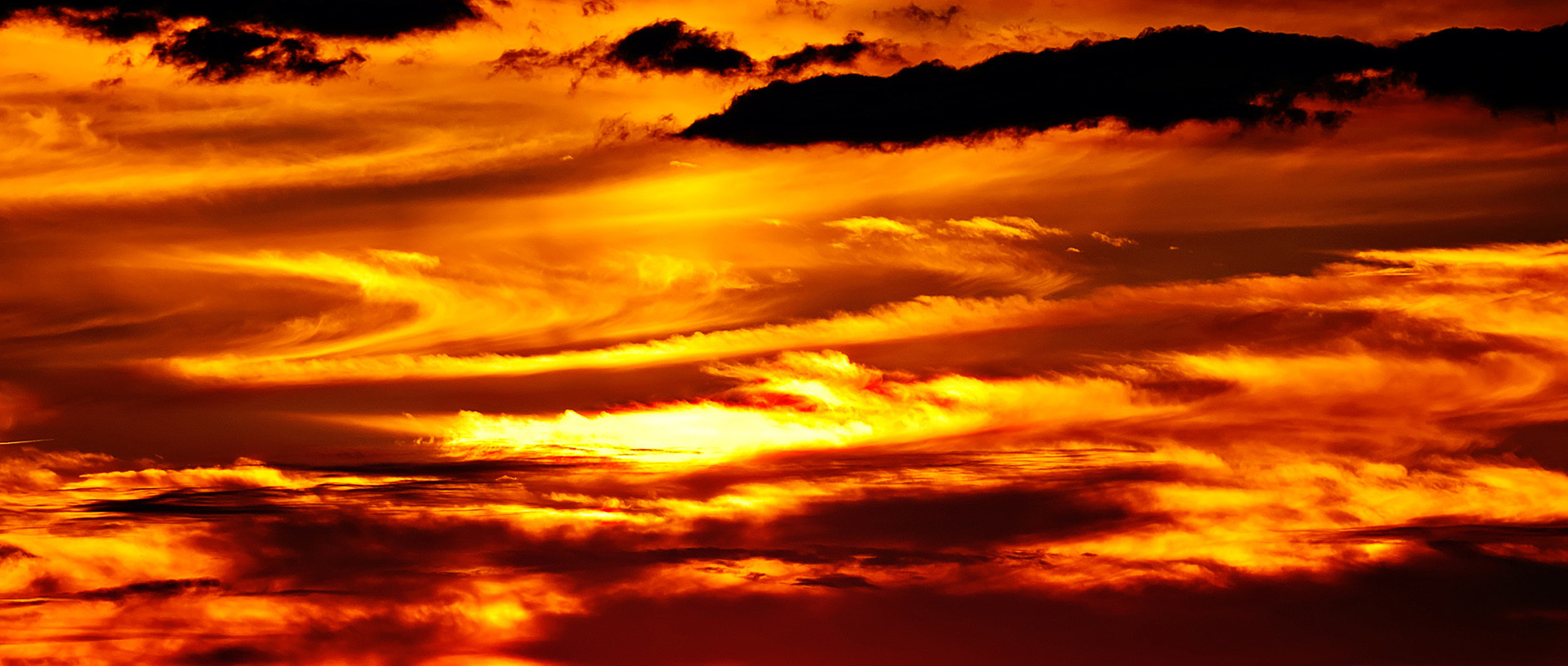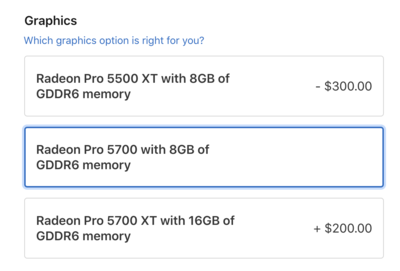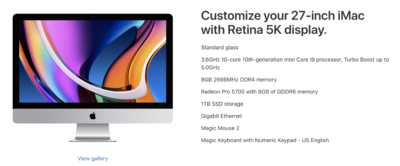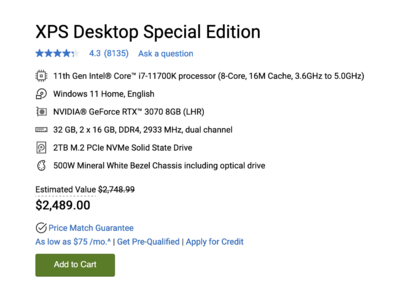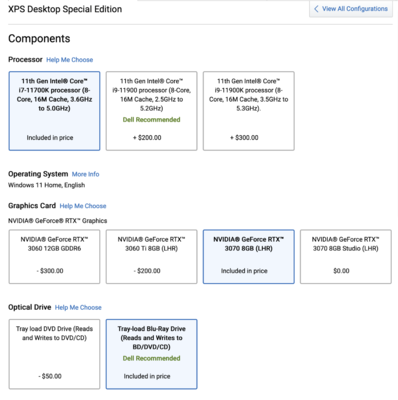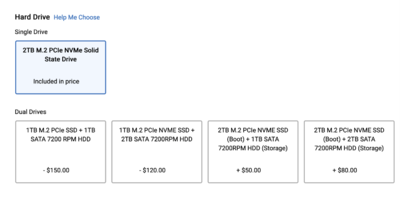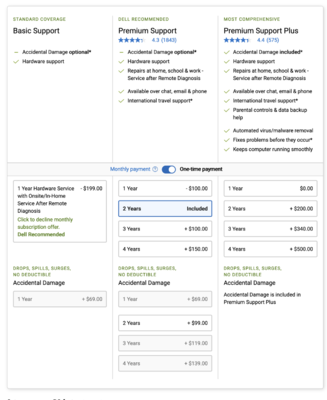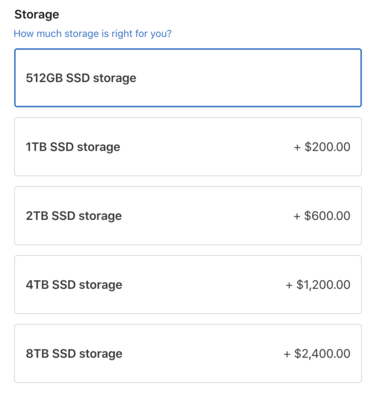-
Posts
4,090 -
Joined
-
Last visited
-
Days Won
48
Everything posted by Brian
-
I'd upgrade the computer and deal with your camera. Seriously. Time is money.
-
Fortunately, Apple's prices haven't changed that much. They are just offering less with their default configurations. (Just like everything else...like you "almost" get a Gallon of Ice Cream these days, or two packs-less in a box of ______, etc.) Yes, COVID-19 and all the BS that is happening is driving up prices. It's insane. A Windows Computer that's "Good for Photo Editing..." costs you just as much as a fancy iMac! I've never seen it this bad, it's just the worse time to be in the Market for a new computer. Also, when it comes to Macs, it's always better to order it on their website and have it shipped to a Apple Store if you have one nearby. Not only does it give you free shipping, you won't have a $3600 computer sitting at your door screaming "STEAL ME!!!"
-
Yeah, that controls the Wireless Card. It would be best if you hooked up your computer via a hard-wire Ethernet Cable and to disable the Wireless software (Killer Control Center) from starting Automatically. But if you are using WiFi to connect to the Internet, you are kinda stuck with it. Man, I hate WiFi. It depends on the License that you purchased. Some info here. If you only purchased the one-computer option, it won't install on a 2nd device. You need the more expensive Webroot that does 5 Devices. From what I can see, is the Western Digital Software that thinks it's "helping" you...I'd un-install that. WD Software has never been useful, and I've dealt with it since the early 1990's. As far as the Chrome, maybe try un-installing it, reboot and then re-install? Each Browser Tab you have open takes a chunk of RAM. But it sounds like you only have one open? Or is there more?
-
Here is your answer: "NVIDIA 2GB graphics card..." Today's Modern Photoshop CC relies on the Graphics Processor and Dedicated Video RAM as a performance boost. The guy from Adobe is right, 2GB isn't going to cut it. At all. How do you upgrade it? Buy a new iMac. Hopefully, this is a 27" iMac. If it's a 21.5" Model, take it to a repair shop that specializes in Macs. Because when it comes to the 21.5" iMacs, there is no access panel to get to the RAM slots on the back side of the Motherboard. In fact, you have to take apart the entire 21.5" iMac and then remove the Motherboard. Actually, I recommend at least 8GB. I'd return the RAM and buy a new 27" iMac. 7 Years is a good run. Also, you might have one of those Fusion HDs installed in your iMac, and they aren't known for their performance. In case you are wondering, start with the most expensive 27" iMac and upgrade a few things: Leave it at the Standard Glass Upgrade the CPU to the i9 version Leave it at 8GB (more on this later...) Upgrade the Video to the middle one, Radeon Pro 5700 with 8GB of Video RAM. Upgrade the internal HD to 1TB SSD Storage I'd upgrade the Keyboard to the one that has the built in Numeric Keypad. It's totally worth the extra $30. When finished, it should look like this: The Cost should be $3229 before Shipping, Tax and AppleCare. Price is US-Dollars. The reason why we are leaving it at 8GB, is I don't want you to pay Apple's over-priced RAM. You will buy a Crucial 64GB kit to take your RAM from 8GB to 72GB for about $350-ish. You'd spend over $1000 for the same damn thing (the 64GB RAM option) AND have LESS RAM AT THE END. (72GB vs 64GB.) So why pay more and get less? Oh, why start with the most expensive iMac? Because it will save you money. Let me explain... Apple is and always been a "Go Big or Go Home" Company. You are penalized for spending less. If you chose a lower-priced iMac, you will end up paying MORE FOR THE UPGRADE OPTIONS. Apple will charge you $100 more for the same damn HD upgrade if you went with a lower-priced iMac. So when it's all-said-and-done, you only save about $100 with going with a lower-end / wallet-friendly iMac. It's not worth it. At over the $2000-$3000 price-point, a $100 is nothing. I'd rather have you get the best hardware options so that your next iMac lasts 7-8 years. Otherwise you will be in the Market sooner rather than later. When I configure my Macs, I have a 7-8 year lifespan in mind Which leads me back to my advice above: It's time for a new iMac. I know, it sucks having to fork out the money. It's just not worth it. You might get another 6-12 months of usage after increasing the RAM, but honestly...it's time.
-
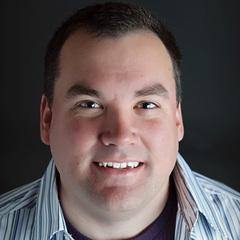
gear suggestion for 6th grade photography class
Brian replied to TheGonzoFamily's topic in Photo Gear & Equipment
Oh, one more thing! I saw that there is a Nikon Shooter in your bunch. If they have a Crop-Body, they really should consider buying this lens: Nikon AF-S DX NIKKOR 35mm f/1.8G Lens Now, since that lens has a "DX" stamped on the side of it, that lens is meant for Crop Body / Nikon DX Bodies ONLY! So if they have a Full Frame / FX body, they are better with a 50mm f/1.8 Lens of some kind. That said, the 35mm 1.8 DX lens should be in every Nikon Crop-Shooter's bag...it's that good AND it's only $196 new. -

gear suggestion for 6th grade photography class
Brian replied to TheGonzoFamily's topic in Photo Gear & Equipment
Yeah, your 18-55 "Kit Zooms" are really crappy. You just have no idea of how bad they are until you shoot with L-Glass. 35mm 1.8 Lenses or even a 28mm 1.8 Lens will work. Not only will you get better results, it will make them think about composition and they will have the wider apertures to play with in low-light. Can't do that with a Kit Lens. Plus, you are right, you have a bunch of 12 year olds. Those Rebels need to be "Throw-Aways" if they are broken. -
That kit is two 16GB sticks. The NZ link will bring your Mac to 40GB, not 72GB. Which is fine unless you have a high MP camera, 45MP or higher. Then you really want 64GB or more. But that RAM you linked to should also work.
-
I hate wasting money on this shit. $1400 (or whatever) is still $1400. I’d hate for you to blow that money, only to turn around and have to purchase more because it’s under-powered. My Advice: Keep Saving. Shoot Less and Photograph More. Having 5 or so photographs that are AWESOME is much better than dealing with 50 crappy or “meh” photos.
-

gear suggestion for 6th grade photography class
Brian replied to TheGonzoFamily's topic in Photo Gear & Equipment
I know exactly what you are going after. You see, I was one of those kids…back in 1986. In reality, any rebel body 6MP or more is fine. I’ve bought stuff used from KEH.com and B&H Used Store. What you really should be looking at is the lens choices that the students will be using. I started with a Minolta X-370 and a 50mm f/1.7 Lens. (Yes, Minolta liked to be different, it was a 1.7 and not a 1.8 lens.) I’d recommend getting 35mm 1.8 or f/2.0 lenses, with the crop-factor that puts the FF equivalent to 56mm with Canon Crop Bodies. (Focal Lenght x 1.6). If any students are shooting with a Nikon Crop Body, I HIGHLY RECOMMEND the Nikon 35mm f/1.8G DX Lens Same thinking, different manufacture Also, having a flash for those low-light situations is also something that students need to learn. Oh, another thing that needs to be taught, is controlling DoF between f1.8-f/22, which makes a 50mm 1.8 Prime essential. (And I’m a Zoom Guy.) In todays world, kids can produce great photos in low-light with their phones, so it’s tough to purchase all the equipment that is needed to compete, especially if you are using old Rebels from a few years ago. As far as publishing, I’ve had things in yearbooks with a 50mm 1.8 lens, so it’s quite possible. It’s also really easy to be able to zoom and not think; if they only have access to kit zooms of the 18-55 Variable Aperture Class, since they are used to your L Glass, their results will be mixed. More-so than before. So to answer your question, any Rebel or Nikon D3000 (and above is fine.) I would recommend models that have a decent amount of Focus Points though. That might help things in the AF dept. -
I’m so jealous, you can go up to 128GB of RAM. What I would do is purchase this Crucial 64GB RAM kit from B&H. Remove the existing RAM, install the Crucial RAM into the slots that the Apple RAM currently resides in, then move/install the Apple RAM to the current empty slots. When finished, you will have 72GB of RAM to play with. Big difference between 8GB and 72. Yes, you can install it yourself. It takes about 5 min or so. Lots of YouTube videos demonstrating the process.
-
I’m not a fan of Corsair Power Supplies. While they are very common, when they die it takes months for them to be replaced under warranty. Lots of unanswered emails…their customer service just sucks. The Video card choice is a bit “Meh” as well. You really want a MSI NVIDIA GTX 3070 8GB and those cards are going for $1500 all by themselves these days. Photoshop LOVES that card Even though that PC is close to $1500, it’s like a $500 PC a few years ago. Prices are still insane. Everything else is ok for the most part. In reality, your budget needs to be around the $2500 mark and getting the Video Card I recommend is tough. While things are “better,” COVID and the ships stuck off the coast of Los Angeles are still messing with supply and prices. Things are double / triple in cost than what they should be.
-
D850 Questions... Post in the Gear Talk section of Ask Brian. Color Checker... That's a Small Color Chart that software detects and then tries to make the best educated guess on what the colors, contrast and white-balance should be. It's not necessary. What is necessary is a set of physical test prints to compare your screen to. Not only in terms of color but overall brightness as well. The rest? It's just gadgets and gizmos for you to blow money on. Photography is full of them...all dedicated to "Take YOUR Photography to the NEXT LEVEL!!!" (*ahem* part with your hard-earned money. )
- 1 reply
-
- 1
-

-
The first thing you need to do, is look for the Display Panel Type under the Technical Specifications. IT’S GOTTA BE IPS or In-Plane Switching. Why is this so important and why do I jump-up-and-down about it? IPS Screens ensure Color, Contrast, Clarity and Sharpness from edge to edge. Which is kinda important for editing photos. You also get a larger viewing angle of around 170°. Unfortunately, these display panel types are tough to find on laptops. Why? Because for the very reason you are wanting a laptop: Portability. TN screens or Twisted Nematic, and variations based on this panel type are great for video games, using your laptop in a coffee shop or airport, watching a movie on a plane, etc. etc.; basically, they are good for everything BUT photo-editing. They are also much cheaper to produce, so manufacturers tend to use them. Combine that with Photoshop’s requirement of a dedicated video GPU AND VIDEO RAM, meaning you don’t want the CPU and regular RAM being used by the video card. Why? Photoshop will complain and run like a slug. Things like liquify and content aware use the GPU in order to work now. And as PS gets more and more fancier tools, the more it will rely on the GPU and dedicated video memory. Why? Speed. For the very reason that Bitcoin Miners use lots of video cards to compline things to get crypto-currency, Photoshop uses a video GPU as a performance boost for their fancy tools.
-
Nope. See this? That is not a IPS-Based Display. That screen is good for gaming, not photo-editing. That said, it checks all the other boxes; though those dual graphics setups often confuse Photoshop. In order to use that Laptop for Photo-editing, you are using an external IPS Display and basically turning your Laptop into a Desktop.
-
Yeah, this is plausible. It sounds like you might have the wrong drivers installed. I'd un-do what you did and see if you can find older drivers. Just think, it's already broke. Nowhere to go but up from here. If you do find a solution, post it here, just in case if someone else has a similar problem.
-
Found this: https://support.wacom.com/hc/en-us/articles/1500006273501-Why-is-my-tablet-not-pairing-over-Bluetooth-or-not-showing-up-under-Bluetooth-settings-when-in-pairing-mode- ...and this: http://101.wacom.com/UserHelp/en/Wireless_ChangeConnection.htm Tablets have been Damien's thing. Personally, I've never used one. I'd try shutting off the Bluetooth in your Tablet first.
-
Yes. The cost about $30-ish. Here is a quick search on Amazon: https://www.amazon.com/s?k=usb+to+m2+ssd+adapter&crid=230CLYJIRBE92&sprefix=usb+to+m2%2Caps%2C94&ref=nb_sb_ss_ts-doa-p_4_9 After your computer boots, then attach the USB Cable and your old drive should appear in "Computer." What drive letter, I couldn't tell you. It could be D or E, but you will see it. You might want to turn on "Show Hidden Files and Folders" just in case under the View Options. Then it's just a matter of digging through the folders on where your data is. I'd start in the "Users" Folder on that old drive and work your way down.
-
Find the latest version of your Video Drivers, download and install them. Windows is complaining that it can't find a program that's more than likely associated with your old profile. It happens. Yeah, you could fix it...but this is kinda a Brian fixes it thing. Like Damien does "Damien Only Edits." More trouble than it's worth over a forum. I'd personally just re-install your video drivers and controller software.
- 1 reply
-
- 1
-

-
Here, buy this one: Dell XPS Special Edition You want 2 years of Dell Premium Support Of course, you can upgrade any item, like the CPU or RAM to 64GB; it all depends on how much money you want to spend. Now the next question I'm sure you will ask, "Do I need a faster CPU and 64GB?" You can never have enough Storage, RAM, CPU, Horsepower...Bigger-Better-Faster-More. Need 64GB? I'd recommend it. Especially if your camera has a lot of Megapixels. Like more than 45MP. OR if you are like my wife who always has 50+ Tabs open in Chrome, because... "They are ALL important!!" LMAO!! In 2022...I'd say 16GB is still the bare-minimum with 32GB really where you want to be for normal usage. 64GB is nice to have though. As far as CPU...sure if you can afford it, a Intel i9 won't hurt things. (The Middle Option for a few hundred more.) Again, it all depends on your budget. But trust me on that Video Card!
-
I don't trust Segate Drives. At all. Out of those three, I'd pick the SanDisk. This one has been on my Amazon Wishlist for quite some time. https://www.amazon.com/dp/B078STRHBX/?coliid=I2B8JPO02UWSG4&colid=IKOJW6U0I11M&psc=1&ref_=lv_ov_lig_dp_it I like the built in loop better than that fabric one.
- 1 reply
-
- 1
-

-
Now putting in a 8TB in your old iMac is pushing it. But a 2TB? That was an upgrade option when you Mac was brand new. Thing with Apple is they like putting in minor stuff to make their hardware different. That's why you need the kit, we have to fool one of the proprietary sensors. Not a big deal, just something that we need to do.
-
2TB SSD Drive: Samsung EVO 870 2TB SSD Drive. You will also need one of these kits: OWC Hard Drive Upgrade Kit for iMac 27" That's what you need. One of each. Bottom Line: DO NOT PUT IN A TRADITIONAL SPINNING HD IN YOUR IMAC!! It's SSD or bust! It's 2021, almost 2022.
-
They are Bullshitting you. Here are the choices on the Apple Website: You see the 8TB storage with the letters "SSD" after it? Don't tell me that a SSD larger than 512GB doesn't exist!! I have a damn 1TB in this iMac that I'm typing this sentence on as of right now. F'ing Apple Genius Bar. I know for a fact, they aren't Geniuses, in ANY sense of the word. They probably don't have them in stock. Honestly? With such a Bone-headed statement like that, I'd cancel the appointment, find a local repair place that does iMac work and see if they can upgrade your HD. Bonus Points: See if they will allow you to bring in a Samsung SSD Drive for them to install. Granted, they won't warranty it, but at least you will have the satisfaction of knowing you have a decent HD.
-
There are none. Seriously. Apple Devices look better with Apple Displays. Unfortunately, there aren't any currently for sale less than $5000. "But Brian, I've seen some really nice 4K Displays..." Yep. Just wait until you hook it up to a Mac Mini and text looks blurry. It will not look like the Apple products you are used to. Here are my recommendations: I'd still buy an Intel-based iMac today myself.
-
Be forewarned, some older software / plug-ins might need to be upgraded if they are 32-Bit. Catalina killed all support for 32-bit software. It's 64-bit or bust! In addition, you will need to be running Adobe PS CC 2020 or 2021/2022 to work with Catalina. If you are still using CS6, PS flat-out WILL NOT WORK. Hell, I don't think it will install. Even though CS6 is 64-bit, the programing language that was used to create / compile the software is no longer supported in Catalina. So if you upgrade, you are upgrading your Photoshop as well if you haven't already. So with all things considered, this is a good time for a Fresh OS, Fresh Photoshop, etc.

